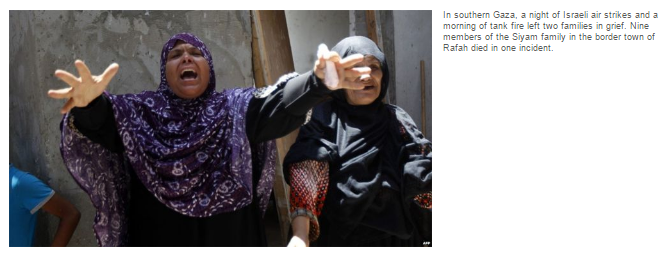On July 21st 2014 the BBC News website published an article titled “Gaza crisis: UN calls for ceasefire as deaths pass 500” in which readers learned that:
“Overnight air strikes in southern Gaza kill more than 30 members of two families in Khan Younis and Rafah, local officials say”.
On the same date the website also produced a photographic feature titled “Gaza crisis: Fear and funerals” which included two images relating to the family in Rafah which the BBC again described as having been killed by Israeli fire.


That incident was the subject of a subsequent investigation and the Military Attorney General recently published its findings (section 3 here). [emphasis added]
“In media reports, as well as in a complaint and in reports of NGOs and international organizations, it was alleged that on 21 July 2014, 12 members of the Siyam family were killed as the result of an IDF aerial attack in Rafah. According to the principal allegation raised by the abovementioned complaint and reports, members of the Siyam family left their residence and went into the street after the family home was damaged as the result of an aerial strike on an adjoining building. It was alleged, that at the time that the family was evacuating their residence, and while they were in the road, aerial fire was carried out against a number of the family members, resulting in their deaths. The different sources were not consistent as regards the various details relating to the event, or in regards to the type of munition alleged to have struck the family members. The incident was subsequently referred to the FFA Mechanism for examination.
The factual findings and the material collated by the FFA Mechanism and presented to the MAG indicate that no attack – aerial or otherwise – that could have resulted in a strike on the family as alleged was carried out by IDF forces in the area in question and on the relevant date. The FFA Mechanism also ruled out the possibility that the types of munition described in a number of the reports had been utilized.
Nonetheless, it was found that at the relevant time, and in close proximity to the Siyam family’s residence, terror organizations in the Gaza Strip fired a series of mortars, aimed at the territory of the State of Israel. A number of these launches were “failed launches”, wherein the mortar shells that were aimed at Israeli territory, fell within the territory of the Gaza Strip. Images showing the points of impact of the munitions that struck the Siyam family and the surroundings of their residence, which were provided to Israel by one of the organizations and transferred to the FFA Mechanism for examination, also indicate that the strike in question was not caused as the result of an aerial attack as alleged in the majority of the reports. The FFA Mechanism and the MAG Corps made representations to the legal representative of the organization which had claimed that the strike on the Siyam family had been caused by IDF munitions, in order for them to present evidence that would support such an allegation. These representations did not receive a response.
After reviewing the factual findings and the material collated by the FFA Mechanism, the MAG found, that contrary to the allegations, it could be concluded, with reasonable certainty, that the members of the Siyam family were not harmed as a result of IDF activity. As such, and in the absence of a reasonable suspicion of criminal misconduct, the MAG ordered the case to be closed, without opening a criminal investigation.”
The two BBC reports inaccurately stating that members of the Siyam family were killed by an Israeli strike remain accessible online and are therefore potentially the subject of editorial complaints according to BBC editorial guidelines.
“However long ago our online content was first published, if it’s still available, editorial complaints may legitimately be made regarding it.”
Clearly clarifications need to be appended to both the reports concerned in order to avoid any further misleading of audiences with inaccurate information and the potential waste of resources on handling avoidable complaints.
This incident once again highlights the fact that the BBC’s standard portrayal of casualty figures in the Gaza Strip during the 2014 conflict does not adequately clarify to audiences that some of the civilian casualties were caused by the actions of Palestinian terrorist organisations.



